- About MAA
- Membership
- MAA Publications
- Periodicals
- Blogs
- MAA Book Series
- MAA Press (an imprint of the AMS)
- MAA Notes
- MAA Reviews
- Mathematical Communication
- Information for Libraries
- Author Resources
- Advertise with MAA
- Meetings
- Competitions
- Programs
- Communities
- MAA Sections
- SIGMAA
- MAA Connect
- Students
- MAA Awards
- Awards Booklets
- Writing Awards
- Teaching Awards
- Service Awards
- Research Awards
- Lecture Awards
- Putnam Competition Individual and Team Winners
- D. E. Shaw Group AMC 8 Awards & Certificates
- Maryam Mirzakhani AMC 10 A Awards & Certificates
- Two Sigma AMC 10 B Awards & Certificates
- Jane Street AMC 12 A Awards & Certificates
- Akamai AMC 12 B Awards & Certificates
- High School Teachers
- News
You are here
Mathematical Treasure: Daniel Schwenter’s Delicia
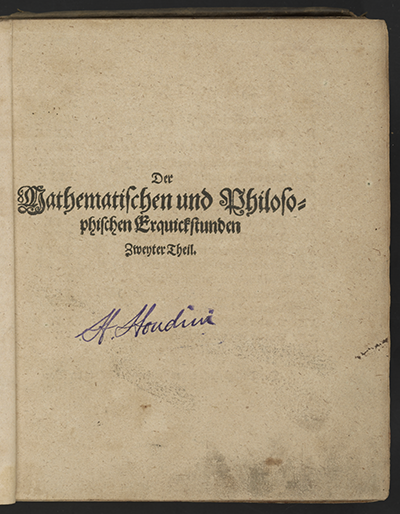
Daniel Schwenter (1585-1636) was a German Orientalist and mathematician. In 1636 he published Delicia Physico-Mathematicae, or Der Mathematischen und Philosophischen Erquickstunden, a book of mathematical recreations and puzzles. Despite its initial Latin title, the text was written in German and became very popular. Gottfried Wilhelm Leibniz, as a young student, worked its combinatorial problems. After Schwenter’s death, Georg Philipp Harsdörffer, a Nuremburg colleague and fellow scholar, reprinted and extended the work to three volumes (1651-1653), making the Delicia the most comprehensive book of the period on mathematical amusements and puzzles. It was reprinted in 1677 and 1692. An introductory title page of the series bears the signature of a previous owner, Harry Houdini (1874-1926), the American “escape artist” and student of magic and the supernatural. During his lifetime, Houdini acquired a collection of rare books as references on magic and illusions. The images in this series were obtained from the Digital Collections of the Library of Congress. The whole volume of Delicia can be viewed on the Library’s website.

Here is the formal title page for the second volume of Harsdörffer’s extended version of the Delicia (1651). Note that he listed some of the scientific contributors, including the mathematicians Rene Descartes, Marin Mersenne, and Orontio (Oronce) Fine.
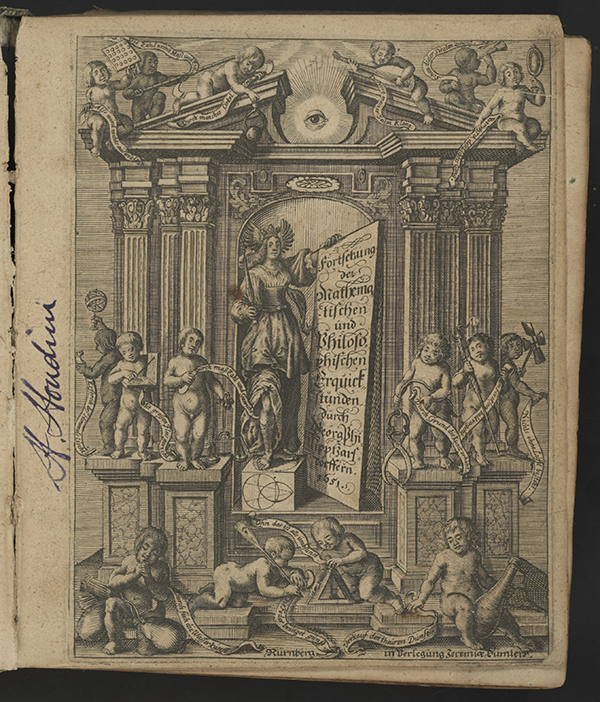
This is the plate that introduces a special original section of the work composed by Schwenter in which he discussed aspects of sixteen sciences from numerical reckoning, Rechenkunst, to the science of air, Luftkunst. Sixteen cherubs are shown frolicking around a central figure who urges the viewer to consider the contents while the “eye of God” surveys the scene. Each cherub represents a specific science to be reviewed; the top most right cherub is concerned with reckoning.

Here is a copy of Schwenter’s original 1636 Delicia introductory plate for his discussion of specific disciplines. The viewer may compare the two versions to see how the various sixteen disciplines are illustrated and attempt to determine the nature of each. Rechenkunst is represented by illustration number 1. Unlike the other images in this article, which are presented courtesy of the U.S. Library of Congress, this image is shown through the courtesy of the European e-rara archive.

Page 5 contains the first and second lessons, aufgabe, for the discussion on reckoning. Lesson I presents the Hindu-Arabic (or Indo-Arabic) numerals and correlates them with their “barbaric origins.” However, the symbols for the barbaric numbers do not match any currently known predecessors and are, perhaps, fanciful in their conception. Lesson II supplies a theory as to how the Roman numerals came into being from hand gestures. Today, John Wallis generally is credited with introducing the lemniscate symbol for infinity in 1655; however, Schwenter’s use of the symbol predated that of Wallis.
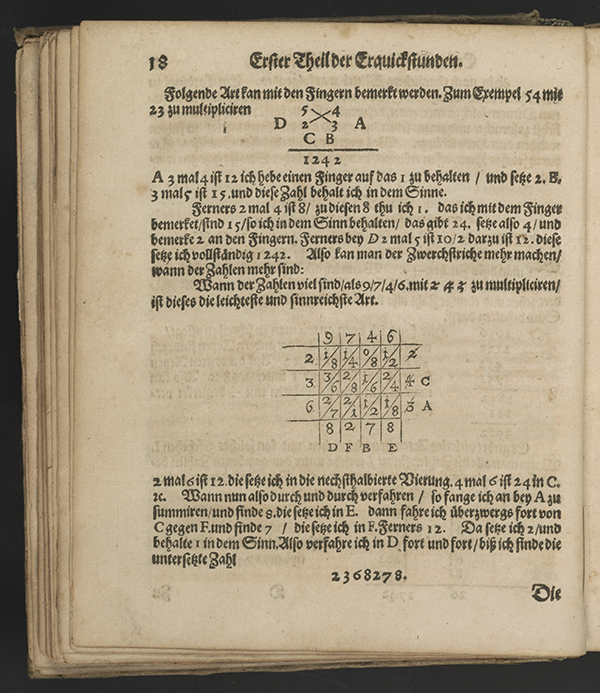
On page 18, two examples of multiplication are given: multiplication “by the cross” and multiplication by the “lattice” or “gelosia” method. The cross method was used for finding the product of two two-digit numbers; the example given is 54 x 23 = 1242. Gelosia allowed for the product of two multi-digit numbers; the example is 9746 x 243 = 2368278.
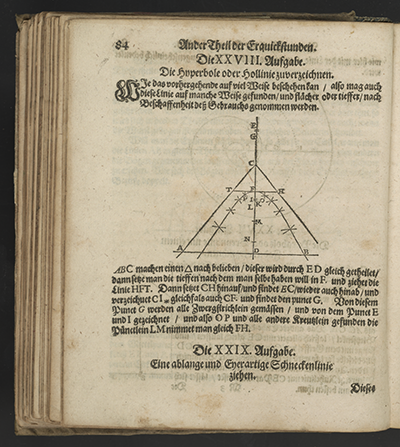
The second category in the listing of sciences is Die Messkunst or art of measurement. It is a consideration of both geometry and surveying. Here on page 84, Schwenter illustrated a method for the construction of a hyperbola. The viewer may determine if this method is correct.
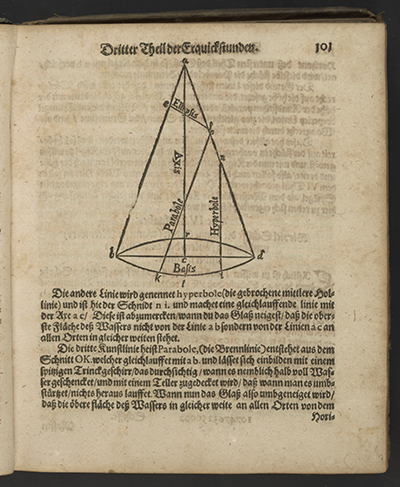
Schwenter provided an illustration of the conic sections as sections of a cone on page 101.

Here on page 81, the author demonstrated how to construct an egg-shaped oval and then, by employing a string and two pegs, the mechanical construction of an ellipse. By associating these two shapes, Schwenter illustrated his grasp of conceptual learning.
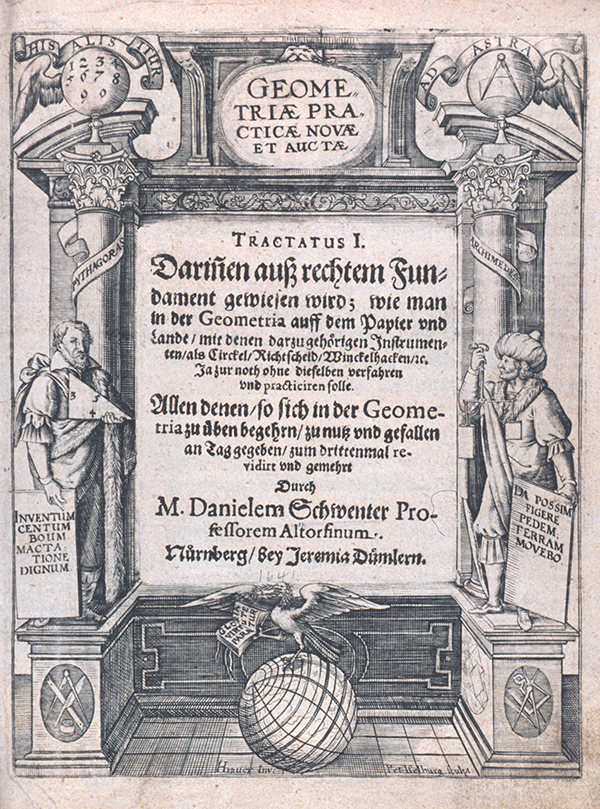
Daniel Schwenter was also noted for his knowledge of Euclidean geometry and wrote a four-volume work on the subject: Geometriae practicae novae et auctae tractus, published posthumously in 1641. This is the title page for the first volume of this work. Note the mathematical symbolism depicted. For additional images from Schwenter's Geometriae practicae, see the Convergence article "Mathematical Treasure: Schwenter's Geometriae practicae."
These images are presented here through the courtesy of the Library of Congress.
Frank J. Swetz (Pennsylvania State University), "Mathematical Treasure: Daniel Schwenter’s Delicia," Convergence (August 2014)




